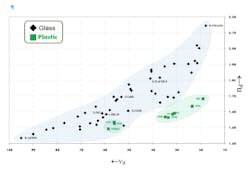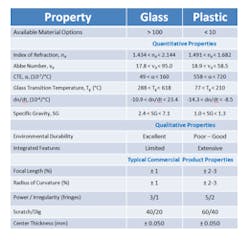MOLDED OPTICS: Precision molded glass challenges plastic optics
Material properties
The process of optical molding—be it injection molding of plastics or compression molding of glass—begins with the raw material (see Fig. 1). Characterization of representative raw materials for molding shows that the solution set for glass is significantly larger than that for plastic: There are well over 100 options for moldable glass, whereas those for optical plastic are in the single digits (see Fig. 2).2,3 Besides this wide choice of options, moldable glass offers additional advantages in terms of material properties (see table). Moldable glass exhibits superior performance in all the quantitative properties, with the exception of specific gravity—it offers a better selection of optical criteria (index of refraction, Abbe number, and optical transmission) and a larger range of other criteria to choose from.The standard transmission profiles of the primary injection-molded plastic optics—COP, PC, and PMMA—show optical transmission is in the high 80% to low 90% range from 350 to 1200 nm. The transmission of most moldable glasses is in the upper 90% range in this wavelength region. And the thermal performance of moldable glass is considerably better than that of moldable plastic: Moldable glasses have higher service temperatures with thermal expansion coefficients an order of magnitude lower. Some moldable plastics, such as PMMA, exhibit issues with water absorption and/or birefringence that can impact optical performance and should be evaluated prior to selection. Weight is the only property for which moldable plastics have a significant advantage over glass: Plastic optics exhibit at least a 2:1 advantage in possible weight reduction.
In terms of qualitative properties, glass optics exhibit significantly better environmental durability and better scratch resistance than plastic optics. Integration of additional mounting features or multiple optical surfaces—one of the primary advantages of plastic injection molded optics—is also possible with lenses formed from PGM, unlike ground and polished lenses. These lenses will typically have an integral mounting flange. Other shapes and features are commonly molded in glass such as lens arrays, stepped features, diffractive surfaces, and noncylindrical outer surfaces. Glass can be molded directly into metal housings with PGM, equivalent to insert molding for plastics. Overall, PGM is limited when compared to the complex geometries possible from plastic optics, but the ability of PGM to provide such features continues to improve.
Consideration of the differences in the molded end product from typical manufacturers highlights PGM as providing a higher-quality standard product than injection-molded plastic optics. This is due—as noted previously—to the better thermal stability, higher optical quality, and greater durability of glass. The molding of glass is less susceptible to shrinkage, which leads to better repeatability from lens to lens and greater consistency in performance.
Cost is one of the primary drivers for component selection and one of the main advertised reasons for selecting plastic optics. Once tooling cost is overcome, the cost of individual plastic optics can be very low. Tooling costs for injection-molded plastic optics vary greatly, with more complicated optics requiring more expensive tooling. For simple lenses the tooling costs can be rather inexpensive. Similar principles apply for PGM so the primary cost comparison should be based on individual components.
At the raw material level, there is no significant difference between materials. Pricing for optical-grade polycarbonate for injection molding was less than $1.00/kg in early 2011 and common borosilicate rod can be purchased for less than $1.50/kg even in low volumes.4 Specialty molding materials such as COP plastic and the high-index moldable glass can be more expensive. This is a generalization, but an important one in that it indicates the cost difference of molded glass vs. molded plastic optics is in the processing and not the raw material.
Material processing
Preparation of raw material for molding is the first processing stage. Thermoplastic resins for plastic optical injection molding come in extruded and cut pellet form. PGM is a near-net shape process requiring a precision preform prior to molding. Preforms can be manufactured by gob forming or by using precision ball preforms—an additional step that does add cost to the PGM process. But glass molding is more efficient in terms of material usage than plastic molding. The excess material from plastic molding can account for up to 98% of the total material used for plastic molding, and it cannot be reused for the majority of optical applications. Pressing glass from a gob, though, is essentially 100% effective use. The primary cost advantage for plastic optics comes from the speed of the process rather than the material cost.
The advantage for plastic is that injection molding is a $141 billion industry.5 Due to its size there has been significant development and innovation in injection molding machines and processes. Plastic optics represents a small portion of the overall market and sits on the extreme edge of processing based on the unique requirements of molded optics. This compares favorably with PGM, which is industry specific and relatively immature.
Precision glass molding can be defined as a high-temperature compression molding process conducted in a controlled environment using optical-quality molds to manufacture optical-quality components or lenses that employs mostly proprietary equipment.2 There has been significant innovation in PGM equipment in recent years, specifically in volume manufacture. The cycle time for an injection-molded 6-mm-diameter plastic lens can be less than 30 s, whereas an equivalent glass molded lens may take up to 15 min. This time difference is minimized by using increased cavitation and transfer molding, with special types of machines developed for high-volume manufacturing. However, the longer processing times and higher temperatures required by glass molding reduce tool lifetime, which does increase the relative cost of components. Plastic optics for very high-volume applications is clearly cheaper than glass, but the gap has closed considerably in the past few years.
The advantages for plastic optics when compared to traditional ground and polished lenses are usually described as low weight, low cost, ability to generate aspheric surfaces, and ease of adding integral features. When plastic optics are compared to precision glass molded optics, however, many of these advantages disappear or are less attractive. Precision glass molding can easily produce aspheric or micro-optic features and can add limited integrated features. While PGM will never compete with plastic optics in specific benefits like weight reduction, the traditional belief that plastic optics have a significant cost advantage over PGM is being undermined; PGM lenses are now frequently used in even the highest-volume, lowest-cost applications, such as cell phone lens assemblies.
REFERENCES
1. A. Maahs, “Plastic optics lower mass manufacturing price tag,” www.optics.org (Dec. 21, 2007).
2. M. Schaub et al., Molded Optics: Design and Manufacture, Chapter 5, “Molded Glass Optics,” CRC Press, London, UK (2011).
3. S. Bäumer, Handbook of Plastic Optics, Chapter 5, “Optical Plastics,” Wiley-VCH, Weinheim, Germany (2010).
4. ICIS.com, Polycarbonate Prices and Pricing Information, http://bit.ly/jqamcI.
5. US Census Bureau, 2009 Annual Survey of Manufacturers, NAICS codes 3261 and 33320 for Plastic Manufacturing.
Alan Symmons | Executive VP of Operations, LightPath Technologies
Alan Symmons is executive VP of operations at LightPath Technologies (Orlando, FL).
Ray Pini | Director of Marketing, LightPath Technologies
Ray Pini is director of marketing at LightPath Technologies (Orlando, FL).


